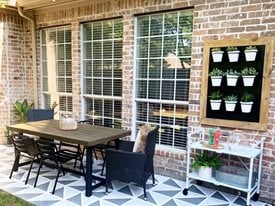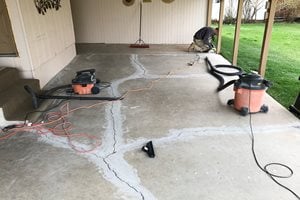
Bethany of Crisp Collective transformed her concrete patio with paint and tape
For many homeowners, concrete patios and porches are extensions of their interior living space, so keeping them looking their best is important. Sometimes that may be as simple as removing unsightly stains and any signs of wear and tear. But with a little time and effort, it’s also possible to completely transform a plain gray concrete patio into a colorful, decorative outdoor floor by applying a coat or two of paint.
Find concrete patio contractors near me.
So what type of paint do you use on a concrete patio, and is painting a concrete patio or porch always a good idea? Before you plunge into a concrete patio painting project, learn more about the pros and cons of painted concrete patios and get tips for choosing and applying exterior concrete paint.
PROS & CONS OF PAINTING CONCRETE PATIOS
PROS
- A major plus of concrete porch and patio paints versus concrete stains is that they come in a much broader selection of colors, allowing you to completely customize your outdoor flooring.
- Today’s exterior concrete paints are designed for high durability and will resist peeling, fading, and abrasion while hiding minor imperfections.
- Can be very economical, especially if you do the work yourself.
- A variety of finishes are possible, ranging from low-luster, to high-gloss, to slightly textured.
CONS
- Paint doesn’t penetrate into the surface like concrete stains do, so weathering and normal wear and tear could cause peeling over time, especially if you don’t prepare the surface properly.
- May require reapplication or occasional touch-ups, especially in high-traffic areas.
- Can result in a slippery surface, unless you use an anti-skid concrete patio paint to improve traction.
WHAT TYPE OF PAINT CAN I USE ON A CONCRETE PATIO?
Not all exterior paints are suitable for concrete patios. You want a product specifically formulated for use on concrete patios and porches, one that contains binders that will allow the coating to expand and contract along with the concrete. The best concrete paints will also resist fading, scuffing, peeling, mildew, and UV exposure.
Most concrete porch and patio paints are heavy-duty acrylic latex formulas that are very effective at concealing minor imperfections and discolorations. These water-based paints are available in a variety of standard and custom colors and in matte, satin, or gloss finishes. Unlike oil-based porch and patio paints, they also offer easy soap-and-water cleanup and are more eco-friendly.
For greater durability, look for a concrete porch and patio paint that is urethane-fortified for superior color retention and adhesion. Also consider using an anti-skid concrete paint that contains a grit additive to improve traction and create a lightly textured finish, especially if your porch or patio is an open area where it can become slippery after exposure to rain or snow.
Learn more about choosing concrete paint.

Justin and Cassity of Remodelaholic ground and filled the cracks in their patio before painting it with a 1-part epoxy floor paint.
HOW DO I PREP A CONCRETE PATIO FOR PAINTING?
Although most concrete patio paints can be applied to previously painted or coated surfaces, be sure to remove any loose or peeling coatings using a wire brush or other abrasion method to sand down to a sound surface. Next, use a concrete degreaser and pressure washer to thoroughly clean the concrete surface from dirt and grime. More stubborn stains such as leaf and grass stains, fertilizer stains, rust, and mold will usually require special cleaners and removal methods. For advice, see Removing Stains from Concrete.
For proper paint adhesion, the concrete surface should also have a slight texture. If the surface is extremely smooth or has a hard-troweled finish, it may need to be acid etched or mechanically abraded first. In addition, some concrete patio and porch paints may require the application of a primer coat to improve bonding. Always read the application instructions on the paint container and follow the manufacturer’s recommendations.
CAN I PAINT A CONCRETE PATIO THAT HAS CRACKS?
Because concrete porch and patio paints are opaque and applied thickly, they do a good job of hiding hairline cracks and other minor flaws in existing concrete. But if you have larger cracks, gouges, or holes in the concrete surface, you will need to patch them first with an exterior concrete crack filler. (Learn more about repairing cracks in concrete patios.) If the cracks are especially large and require extensive repair, you may be better off resurfacing your concrete patio with an overlay rather than painting it.
